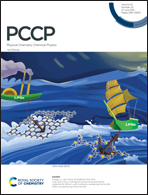Impact of Cu(ii) and Al(iii) on the conformational landscape of amyloidβ1-42†
Abstract
Metal ions have been found to play an important role in the formation of extracellular β-amyloid plaques, a major hallmark of Alzheimer's disease. In the present study, the conformational landscape of Aβ42 with Al(III) and Cu(II) has been explored using Gaussian accelerated molecular dynamics. Both metals reduce the flexibility of the peptide and entail a higher structural organization, although to different degrees. As a general trend, Cu(II) binding leads to an increased α-helix content and to the formation of two α-helices that tend to organize in a U-shape. By contrast, most Al(III) complexes induce a decrease in helical content, leading to more extended structures that favor the appearance of transitory β-strands.

- This article is part of the themed collection: 2021 PCCP HOT Articles


 Please wait while we load your content...
Please wait while we load your content...